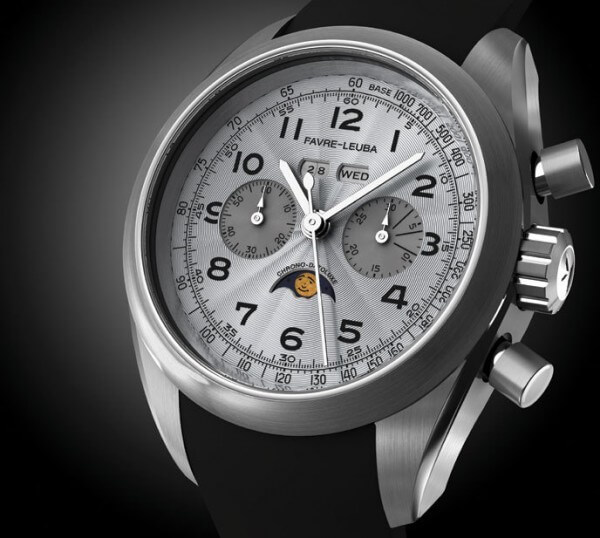“Favre-Leuba is, without the shadow of a doubt, a great name in Swiss watchmaking, and one we are now repositioning with annual production of fewer than 2,000 watches for an audience of aficionados,” Clément Brunet-Moret, CEO of the brand, explains. “We place the emphasis on quality and innovation in exclusive and deliberately small collections.” Taking centre-stage this year are sports instruments, with the Bathy V2 which features a mechanical depth gauge and dive-time indicator, and the Bathy Chrono Triple Time Zone. Another new model, the Angelus Chrono Datolux, will be manufactured exclusively to order. It is fitted with the Angelus movement (column-wheel chronograph, day/date and moon phases). Favre-Leuba was able to recover, in the form of parts, around fifty of these movements which were produced in 1948 when they were also supplied to Patek Philippe.

Favre-Leuba first began to woo collectors last year with its A. Schild model, produced as a limited edition of 100. These incorporated a 1967 Schild base movement, the first to beat at 36,000 vibrations/hour and jointly developed by Girard-Perregaux and Favre-Leuba, which was able to locate a small supply of these vintage calibres. The Mercury collection, the brand’s third pillar, was inspired by the eclipse of Mercury by Venus in 1737, a milestone in the company’s history as this was also the year that the Favre-Leuba manufacture d’horlogerie was officially established. The Mercury collection embraces three models: a Chronograph, a Large Date and a Power Reserve.
A Manufacture movement for 2011
For its non-limited editions, Favre-Leuba has always sourced its movements from Dubois-Dépraz, which supplies calibres made exclusively for the brand. Now, however, the company is intent on reviving its past and producing a movement of its own. “This manufacture movement will be entirely developed in-house. It will beat at 36,000 vibrations/hour, a reference to the brand’s vintage calibres, and will feature two barrels, an eight-day power reserve and a Nivarox balance spring,” notes Clément Brunet-Moret. “We are currently in the initial development phase, with the first launch planned for end 2010, early 2011.”
Favre-Leuba brandishes its past as proof that it is an authentic and legitimate name… particularly since last summer when the new directors came across an original manuscript attesting that Abraham Favre, a former church elder and the “father of the firm,” began to explore the complexities of watchmaking in 1718, under the expert eye of Master Gagnebin. Eight successive generations would take the company, officially established in 1737, from strength to strength, first drawing on a collaboration with the father of Swiss chronometry, Jacques-Frédéric Hourriet (1743-1830), and then in the early nineteenth century a partnership with another family of watchmakers, the Leubas. A new era of expansion dawned, as the brand conquered new and distant markets in the United States, Chile, Lebanon, Bahrain, Singapore and India. Later decades would be marked by technical innovation, particularly the years between 1940 and 1970 with the Bivouac (1962), a mountaineer’s watch including an altimeter and an aneroid barometer, worn by Paul-Emile Victor and Walter Bonatti on their expeditions, and the Bathy (1966) which featured the first mechanical depth gauge and a dive-time indicator.
The golden years of the 1960s
Says Clément Brunet-Moret: “This was a decade during which Favre-Leuba scaled new heights. Its creativity and expertise were evident in the 650,000 watches it produced each year. These covered every price range, from a few francs for the Indian market to the very top of the range. With its three manufacturing plants in Switzerland, contracts to produce under licence, in particular for Christian Dior, and partnerships with Schild and Girard-Perregaux to develop the famous 36,000 vibrations/hour movement, this was a golden age for Favre-Leuba.” Yet this family business fell victim to the battles waged by the major groups in the final decades of the twentieth century. The Favre family first sold the brand to the Saphir group, which merged it with Jaeger-LeCoultre, albeit briefly as it went on to sell both firms.
After changing hands several more times, Favre-Leuba eventually became part of the LVMH group. The luxury giant would hold on to the firm for twenty years, solely interested in its production capacities for Montres Dior without ever investing the resources to re-launch the brand. When the licensing agreement reached its end in 2003, Favre-Leuba was again sold, this time to a family of watch connoisseurs whose portfolio includes other brands and contractors in the branch. A last change of ownership and, since 2006, a new positioning that should enable Favre-Leuba to pick up the thread of its illustrious past.


















